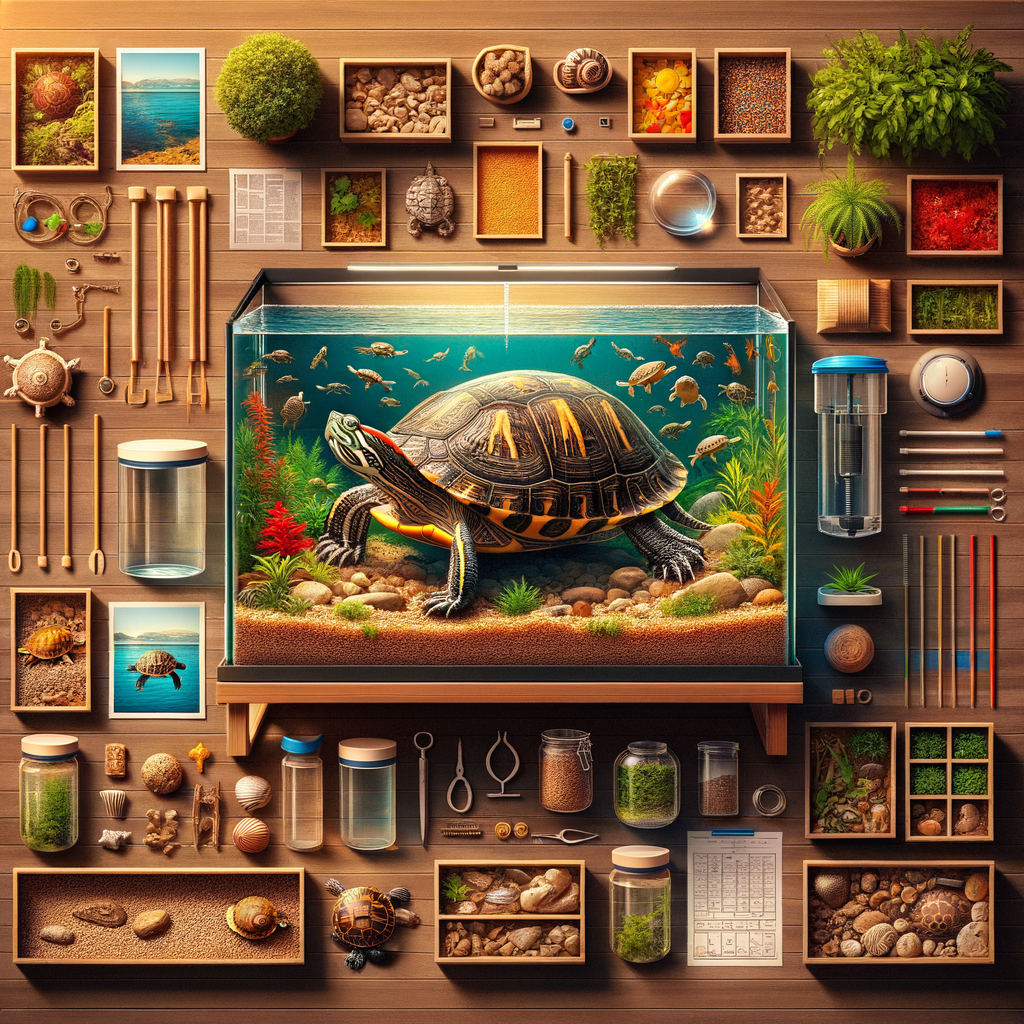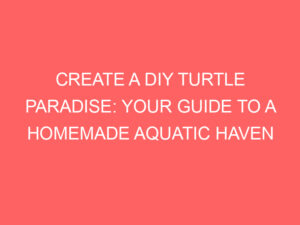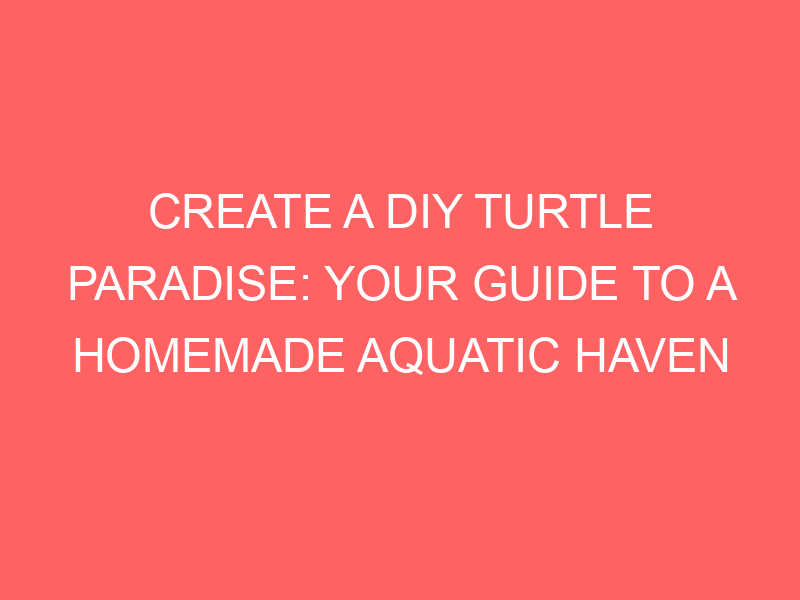
Introduction to Creating Turtle Environments
Creating a suitable environment for your pet turtle is crucial to its health and happiness. This guide will help you understand the importance of a well-set turtle tank and the essential elements it should contain.
- Understanding the importance of a well-set turtle tank
A well-set turtle tank is more than just a home for your pet; it’s a miniature ecosystem that provides everything your turtle needs to thrive. Turtles, like all animals, have specific habitat requirements. If these aren’t met, your turtle can become stressed, which can lead to health problems. A well-set turtle tank recreates the turtle’s natural environment as closely as possible, providing the right balance of land and water, the correct temperature and lighting, and a safe and comfortable place for your turtle to rest and hide.
- Essential elements for a turtle tank
There are several key elements that every turtle tank needs:
| Element | Description |
|---|---|
| Water and Land Areas | Turtles need both a place to swim and a place to bask. The tank should have a deep water area and a dry land area. |
| Temperature | The tank should be kept at a temperature that mimics the turtle’s natural habitat. This usually means a basking area that’s warmer than the rest of the tank. |
| Lighting | Turtles need both UVA and UVB light to stay healthy. UVA light encourages natural behavior, while UVB light helps them produce vitamin D3, which is essential for healthy shell growth. |
| Substrate | The bottom of the tank should be covered with a substrate, like gravel or sand, that the turtle can dig in. |
| Hiding Places | Turtles need places to hide to feel safe. This can be provided by rocks, plants, or specially made turtle hides. |
By understanding the importance of a well-set turtle tank and including these essential elements, you can create a turtle environment that will keep your pet healthy and happy for many years to come.
Setting Up a Turtle Tank: The Basics
Creating the perfect environment for your turtle begins with setting up the right tank. This process involves several crucial steps, each contributing to the overall health and happiness of your pet. Let’s explore the basics of setting up a turtle tank.
Turtle Tank Setup: Step by Step Guide
Here is a simple, step-by-step guide to help you set up your turtle tank:
- Choosing the right tank size
- Setting up the tank
- Adding essential turtle tank elements
The size of your tank is the first and most important consideration. Turtles need ample space to swim, bask, and hide. As a general rule, for every inch of your turtle’s shell length, you should provide 10 gallons of tank space. For example, a 5-inch turtle would require a 50-gallon tank. Remember, bigger is always better when it comes to turtle tanks.
Once you have the right tank size, it’s time to set it up. Start by placing a layer of substrate at the bottom of the tank. This can be a mix of large river rocks and small pebbles. Next, fill the tank with dechlorinated water, ensuring that the water level is deep enough for your turtle to swim freely but shallow enough for it to reach the surface easily. Install a water heater to maintain a consistent water temperature between 75-85°F.
After setting up the tank, you need to add essential elements that mimic a turtle’s natural habitat. This includes a basking area with a heat lamp, a UVB light for vitamin D synthesis, hiding spots, and live plants for additional cover. Also, consider adding a water filter to keep the water clean and a thermometer to monitor the water temperature.
Setting up a turtle tank may seem like a daunting task, but with the right knowledge and preparation, it can be a rewarding experience. Remember, the goal is to create a habitat that is as close as possible to your turtle’s natural environment. This will ensure your turtle’s health and happiness for years to come.
Common Mistakes in Setting Up a Turtle Tank
When setting up a turtle tank, it’s essential to avoid common mistakes that could harm your pet’s health and happiness. Here are some of the most frequent errors:
- Choosing a tank that’s too small: Turtles need plenty of room to swim, bask, and hide. A tank that’s too small can lead to stress, illness, and stunted growth. As a rule of thumb, the tank’s size should be at least 10 gallons for every inch of your turtle’s shell length. For example, a turtle with a 5-inch shell would need a 50-gallon tank.
- Not providing enough hiding spots: Turtles are naturally shy creatures that need hiding spots to feel safe. Without enough places to hide, they can become stressed and anxious. You can provide hiding spots using rocks, plants, and specially designed turtle caves available in pet stores.
- Overcrowding the tank: Overcrowding can lead to competition for resources, increased aggression, and the spread of disease. A good rule to follow is one turtle per 10-15 gallons of water. Remember, turtles need their space just like we do!
By avoiding these common mistakes, you can create a comfortable and healthy environment for your turtle. Remember, a happy turtle is a healthy turtle!
Turtle Habitat Essentials: Creating the Perfect Environment
Creating the perfect environment for your turtle is crucial for its health and happiness. There are several key factors to consider when setting up a turtle habitat. Let’s delve into these essentials.
Understanding Turtle Habitat Needs
Turtles have specific habitat needs that must be met for them to thrive. These include water quality, temperature, and lighting. Let’s explore each of these in detail.
- The Importance of Water Quality
- The Role of Temperature in a Turtle’s Habitat
- Lighting Requirements for Turtles
Water quality is paramount for turtles. Turtles spend a significant amount of their time in water, making it a critical component of their habitat. Poor water quality can lead to health problems such as shell rot and respiratory infections. Regular water changes and the use of a good quality filter can help maintain clean water in your turtle’s habitat.
Temperature plays a vital role in a turtle’s habitat. Turtles are ectothermic creatures, meaning they rely on their environment to regulate their body temperature. A turtle’s habitat should have a warm basking area and a cooler swimming area. The basking area should be around 85-90 degrees Fahrenheit, while the water temperature should be kept at around 75-80 degrees Fahrenheit.
Proper lighting is essential for turtles. They require both UVA and UVB light for their health. UVA light encourages behaviors such as feeding and basking, while UVB light helps turtles produce vitamin D3, which is necessary for calcium absorption and shell health. A combination of natural sunlight and artificial lights can help meet these requirements.
Understanding and meeting these habitat needs will go a long way in ensuring your turtle’s health and happiness. Remember, a happy turtle is a healthy turtle!
Essential Turtle Tank Elements: What to Include
Creating the perfect environment for your turtle involves more than just filling a tank with water. There are several essential elements that need to be included to ensure your turtle’s health and happiness. Let’s explore these in detail:
-
Heating and Lighting Equipment
Just like us, turtles need warmth and light to thrive. A heater will help maintain the right water temperature, which should be between 75 and 85 degrees Fahrenheit for most turtle species. Lighting is also crucial. Turtles need both UVA and UVB light for their health. UVA light helps with their behavior, while UVB light aids in the synthesis of vitamin D3, which is essential for their shell and bone health.
-
Substrate and Decorations
The substrate is the material you put at the bottom of the tank. It can be anything from sand to gravel. It’s not just for looks – it also helps in maintaining water quality. Decorations, like rocks and plants, provide hiding spots and climbing areas for your turtle. They also make the tank look more natural, which can help your turtle feel more at home.
-
Filters and Water Conditioners
Turtles are messy eaters and produce a lot of waste. This is where filters come in. They help keep the water clean by removing waste and harmful chemicals. Water conditioners, on the other hand, remove harmful substances like chlorine from tap water, making it safe for your turtle.
Remember, each of these elements plays a vital role in creating a healthy and comfortable environment for your turtle. So, make sure you include them all when setting up your turtle tank.
Turtle Tank Accessories: Enhancing Your Turtle’s Environment
Creating a comfortable and engaging environment for your turtle is crucial for its health and happiness. One way to achieve this is by adding the right accessories to your turtle tank. These accessories not only make the tank more appealing but also provide necessary functionality for your turtle.
Choosing the Right Accessories for Your Turtle Tank
When it comes to selecting the right accessories for your turtle tank, there are two main considerations to keep in mind:
- Types of turtle tank accessories
- How to choose the right accessories
There are numerous types of turtle tank accessories available in the market. Some of the most common ones include basking platforms, hiding spots, water filters, heaters, and decorative items like rocks and plants. Each of these accessories serves a specific purpose. For instance, basking platforms provide a place for your turtle to rest and soak up heat, while hiding spots offer a sense of security.
Choosing the right accessories for your turtle tank depends on various factors such as the size of your turtle, the size of the tank, and the specific needs of your turtle species. For example, larger turtles will require bigger basking platforms and more robust water filters. Similarly, some turtle species prefer warmer temperatures, necessitating a high-quality heater. Always research your specific turtle species to understand its needs better.
In conclusion, enhancing your turtle’s environment with the right accessories is a vital aspect of turtle care. By understanding the different types of accessories and how to choose them, you can create a turtle paradise that your pet will love.
Rocking the Turtle Tank: Creating a Naturalistic Environment
Creating a naturalistic environment for your turtle is a rewarding task. It not only enhances the beauty of your tank but also provides a comfortable and stimulating environment for your pet. Here are the steps to rock your turtle tank:
- Choosing the Right Rocks and Plants
Choosing the right rocks and plants is the first step towards creating a naturalistic environment. Turtles love to climb and bask on rocks. Therefore, select rocks that are sturdy and have flat surfaces. Avoid sharp-edged rocks as they can injure your turtle. As for plants, opt for aquatic plants that can thrive in a turtle tank. Some good choices include Anubias, Java Fern, and Water Hyacinth. These plants not only add to the aesthetics of the tank but also provide hiding spots for your turtle.
- Setting Up the Rocks and Plants
Once you have chosen the right rocks and plants, it’s time to set them up in the tank. Place the rocks in a way that they form a basking area for your turtle. Ensure that the rocks are stable and won’t topple over. Next, plant your aquatic plants in the substrate. Make sure to spread them out evenly throughout the tank. This will give your turtle plenty of room to swim and explore.
- Maintaining a Naturalistic Environment
Maintaining a naturalistic environment involves regular cleaning and monitoring of the tank. Remove any dead or decaying plant matter as it can pollute the water. Also, check the stability of the rocks regularly. If you notice any algae growth on the rocks or plants, clean them using a soft brush. Remember, a clean and well-maintained tank is key to your turtle’s health and happiness.
| Steps | Description |
|---|---|
| Choosing the Right Rocks and Plants | Select sturdy, flat-surfaced rocks and aquatic plants like Anubias, Java Fern, and Water Hyacinth. |
| Setting Up the Rocks and Plants | Arrange the rocks to form a basking area. Plant the aquatic plants evenly throughout the tank. |
| Maintaining a Naturalistic Environment | Regularly clean the tank, remove decaying plant matter, and check the stability of the rocks. |
In conclusion, creating a naturalistic environment for your turtle involves careful selection of rocks and plants, proper setup, and regular maintenance. By following these steps, you can create a beautiful and stimulating environment for your pet turtle.
Conclusion: The Joy of Creating the Perfect Turtle Paradise
Creating a perfect turtle paradise is not just about setting up a tank, but about creating a habitat that your turtle will love and thrive in. It’s about understanding the needs of your turtle and providing them with a space that mimics their natural environment as closely as possible. Let’s recap what we’ve learned.
- Recap of turtle tank setup essentials
- The benefits of a well-set turtle tank
Setting up a turtle tank involves more than just filling it with water. You need to consider the size of the tank, the type of substrate, the water filtration system, and the heating and lighting requirements. The tank should be large enough for your turtle to swim and explore, and the water should be kept clean and at the right temperature. The tank should also have a dry area where your turtle can bask under a heat lamp.
A well-set turtle tank has numerous benefits. It provides your turtle with a safe and comfortable environment, which can help to reduce stress and promote good health. It also makes it easier for you to observe your turtle and monitor its behavior, which can be useful in detecting any potential health problems early. Furthermore, a well-set turtle tank can be a beautiful addition to your home, providing you with hours of enjoyment as you watch your turtle explore its environment.
In conclusion, creating the perfect turtle paradise is a rewarding experience that benefits both you and your turtle. It requires time, effort, and a deep understanding of your turtle’s needs, but the result is well worth it. Remember, a happy turtle is a healthy turtle, and a healthy turtle can bring you years of joy and companionship.














